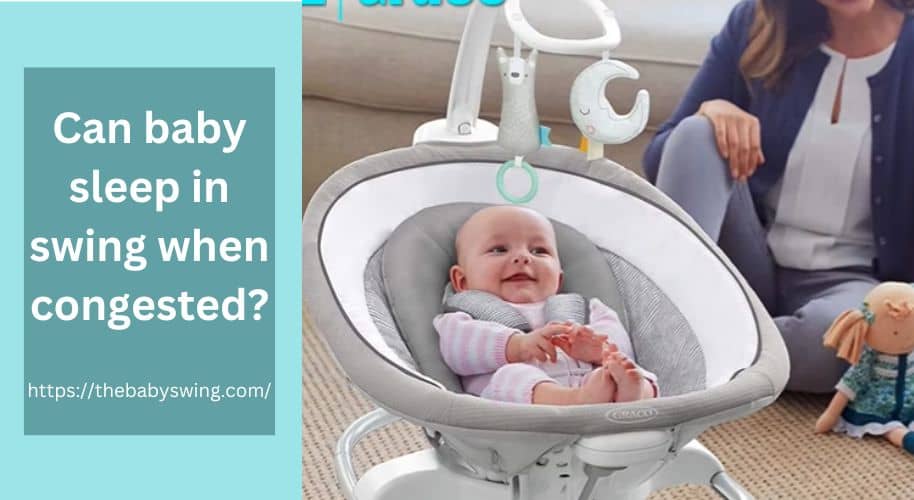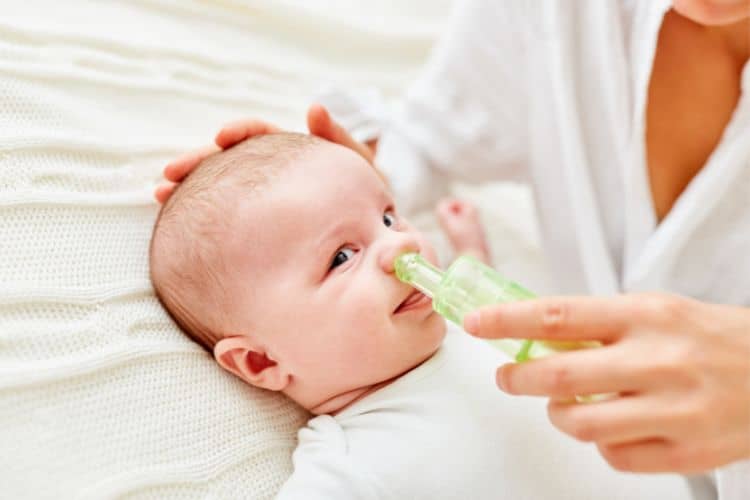Last Updated on July 19, 2023
It’s understandable that parents may want to put their baby in a swing or stroller when they are congested, as it can be more comfortable for them. However, there are potential risks associated with babies sleeping in swings, such as their heads flopping forward and obstructing their airways.
Parents should also ensure the swing is safe and secure so that it does not fall over or spill their baby out.
Most importantly, the American Academy Of Pediatrics (AAP) is against babies sleeping in swings for any length of time, as it can increase the risk of SIDS and other sleep-related deaths.
However, experts say that you can place a congested baby in a swing for soothing. But if they fall asleep, you should move them to a safe sleeping surface, such as a crib or bassinet.
In this article, we’ll discuss how can you help a congested baby sleep, and what you should consider when using a swing for them. So, keep reading!

- Can baby sleep in swing when congested?
- What position should baby sleep when congested?
- Can sick baby sleep in swing?
- How do I break my baby's congestion?
- How long will congestion last in baby?
- When should I worry about my baby's congestion?
- Does breastmilk help stuffy nose?
- Should I suction my baby's nose while sleeping?
- Wrapping Up
Can baby sleep in swing when congested?
As we’ve mentioned above that the AAP recommends avoiding swings for sleeping, as it can increase the risk of SIDS and other sleep-related deaths.
But you can put a congested baby in a swing when they are awake, as it can help soothe and comfort them. However, it’s important to monitor your baby closely while they’re in the swing.
“It’s ok to use a swing for soothing, but if your baby falls asleep in the swing, it’s best to move them to a more safe sleeping surface, such as a crib or bassinet,” says Mattie Johnson, ND, MPH, a primary care pediatrician at Lake Stevens Natural Medicine.
“A congested baby in a swing should be monitored to be sure they can breathe freely,” Matte added.
She also added that there are other safe and effective ways to soothe a congested baby, such as using a humidifier in the room, giving them a warm bath, or using essential oil diffusers.
Also read: Weight limit on baby swing
What position should baby sleep when congested?
If you decide to let your baby stay in a swing while they are congested, keep an eye on them and monitor their breathing.
You should also consider elevating the head of the bed slightly to help with drainage and keep the snot from building up. Additionally, if possible, try to get your baby to sleep in a reclined position instead of upright.
Dr. Mattie emphasizes that the safest way for a congested baby to sleep is on their back on a firm, flat surface in their own crib or bassinet. This position can help reduce the risk of SIDS and other sleep-related deaths.
She also encourages parents to use a sleep sack or swaddle instead of blankets, as this can help keep their baby warm and safe.
Overall, it is best practice for babies not to sleep in swings or car seats unsupervised due to safety concerns. If your baby has a habit of sleeping in a swing, you may need to break this habit by slowly transitioning them into other forms of sleep, such as cribs or bassinets.
Also read: When to stop using my baby swing
Can sick baby sleep in swing?
It is not recommended to let a sick baby sleep in a swing. According to the American Academy of Pediatrics (AAP), babies should never be put to sleep in an infant swing.
The AAP states that swings are not designed for unsupervised sleep and can cause suffocation, strangulation, or other injuries.
Additionally, if a baby falls asleep in the swing and is not in a reclined position, their head may slump forward, which can restrict their airway and cause them to stop breathing.
Dr. Mattie adds that any babies with underlying medical conditions, such as colds or respiratory issues, may have difficulty breathing in a swing and should be monitored closely.
They should sleep on a firm, flat surface in their own crib or bassinet. This can help reduce the risk of SIDS and other sleep-related deaths.
How do I break my baby’s congestion?

Congestion in babies can be a difficult and uncomfortable experience. Fortunately, there are several ways to help break your baby’s congestion.
One safest and most effective ways to help clear a baby’s congestion is with a saline (salt water) spray or nose drops.
These products work by thinning the mucus in the nose, making breathing easier for your baby.
You can also use a humidifier in your baby’s room, as this will help keep their nasal passages moist and reduce any discomfort caused by dry air.
Additionally, you can give your baby a warm bath or sitting them in a steamy bathroom for 10 minutes at a time.
This will help break up the mucus and make it easier for them to breathe.
Finally, you can use breastmilk in the nose as this helps thin out the mucus.
You should remember that if your baby’s congestion persists or worsens over time, it is best to consult your doctor as soon as possible.
Also read: How long can you use Graco swing
How long will congestion last in baby?
A cold or flu virus can last anywhere from 3-14 days. Allergies may last longer and require ongoing treatment. You should consult your pediatrician if your baby’s congestion persists for more than two weeks.
If your baby is congested, there are several things you can do to help relieve their discomfort.
As mentioned above, you can use saline drops or spray in each nostril, run a humidifier in the room, sit in a steamy bathroom with your baby, give them a warm bath, use a warm compress on their chest and back, and incorporate herbs and spices into their diet.
Additionally, you should avoid using over-the-counter decongestants as these are not recommended for babies under two years old.
You should also remember that prevention is key when it comes to babies’ congestion. Make sure to keep up with regular vaccinations and practice good hygiene habits such as washing hands often and avoiding contact with people who are sick.
When should I worry about my baby’s congestion?
If your baby is struggling to breathe or has a fever lasting more than three days, you should consult their pediatrician.
Additionally, you should seek medical attention if they have earache or yellow or green pus from their eyes.
You should also note that mild to moderate congestion is common in babies and should only last for a few days.
If the congestion persists longer than this, it may be time to contact your baby’s healthcare provider.
Furthermore, if your baby has a panicked look, is grunting or moaning at the end of each breath, has flaring nostrils, ribs pulling in on each breath, or is breathing too hard or fast, then you should seek medical attention as soon as possible.
Holding your baby upright can make breathing easier, but if they still have difficulty, it may be time to worry and contact their pediatrician.
Does breastmilk help stuffy nose?
Breastmilk is a natural remedy to help ease your baby’s stuffy nose. It contains buffered saline, which helps break up and thin out mucus, making breathing easier for your baby.
Breastmilk can be used in several ways to help with nasal congestion. You can put a drop or two of breastmilk into your baby’s nostrils, let them sniff it up, or use an electric snot sucker or bulb syringe to remove the congestion manually.
Another option is to squirt a little breastmilk into their nostrils, as this will help relieve the blocked and stuffy nose.
Using breastmilk for stuffy noses is natural but also safe and effective. However, if your baby’s symptoms persist, you should consult your doctor, as other underlying causes need to be addressed.
Should I suction my baby’s nose while sleeping?
It is important to consider suctioning your baby’s nose before bedtime or feeding. Suctioning can help clear mucus and make breathing easier for your baby while sleeping.
However, it is best to avoid suctioning after feeding as this may cause your baby to vomit.
To suction your baby’s nose, first give them nasal drops or 1-2 drops of saline in their nostril. Then hold the baby with their head back for about a minute to allow the saline time to thin the mucus.
After that, use a bulb syringe or nasal aspirator to create suction and remove any mucus from the nose.
If you have any questions about how to suction your baby’s nose properly, you should consult with a doctor or healthcare professional.
Wrapping Up
Thanks for reading this guide on can baby sleep in swing when congested? In short, it’s not recommended to put a congested baby in a swing for sleeping since it can increase the risk of SIDS.
However, you can use it for soothing when your baby is awake. Also, consider using a humidifier or essential oil diffuser to soothe the congested baby.
Always monitor your baby and ensure their airways are clear while in the swing.
Please share this article with your friends and family if you found it helpful!
Sources:
- https://www.cincinnatichildrens.org/health/s/suction
- https://www.nationwidechildrens.org/family-resources-education/health-wellness-and-safety-resources/helping-hands/suctioning-the-nose-with-a-bulb-syringe
- https://myhealth.alberta.ca/health/Pages/clean-out-your-babys-nose.aspx
- https://naturopathicpediatrics.com/2016/03/17/2-simple-tricks-to-ease-your-babys-nasal-congestion/
- https://www.thebump.com/a/baby-congestion
- https://www.romper.com/parenting/when-to-worry-baby-congestion
- https://www.webmd.com/parenting/baby/features/baby-stuffy-nose
- https://www.pampers.com/en-us/baby/health/article/baby-congestion
- https://www.healthline.com/health/newborn-congestion
- https://www.nytimes.com/2020/04/17/parenting/baby-sleep-dangerous.html
Sharing Is Caring!

Amy A. Vincent is a Certified Pediatric Sleep Consultant and a mother of three beautiful children. She helps parents transition their babies from swing sleep to safe, independent sleep. She is passionate about helping parents teach their children the skills needed to become good sleepers and aims to make the process as easy and stress-free as possible. Read more
